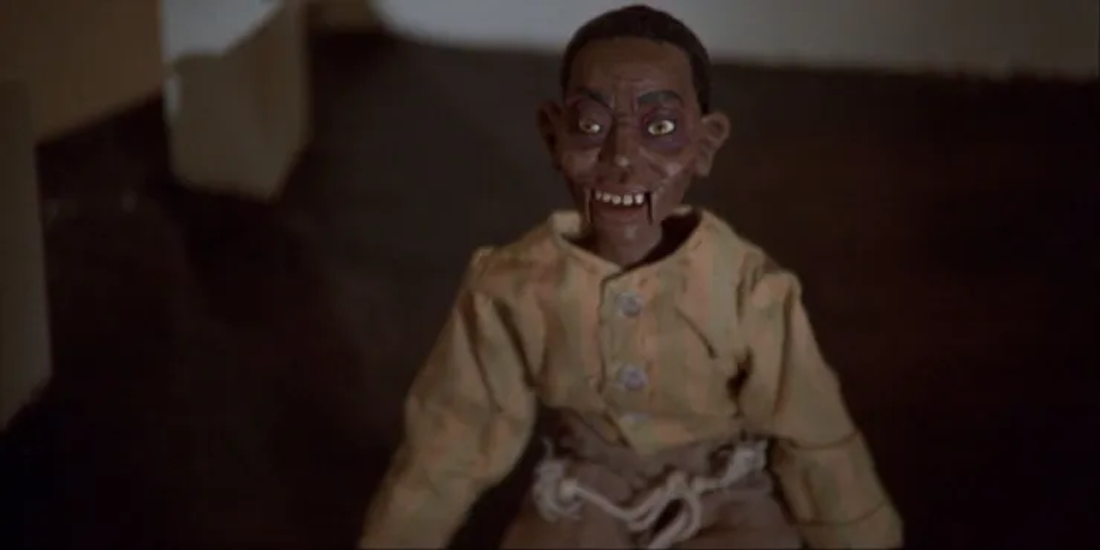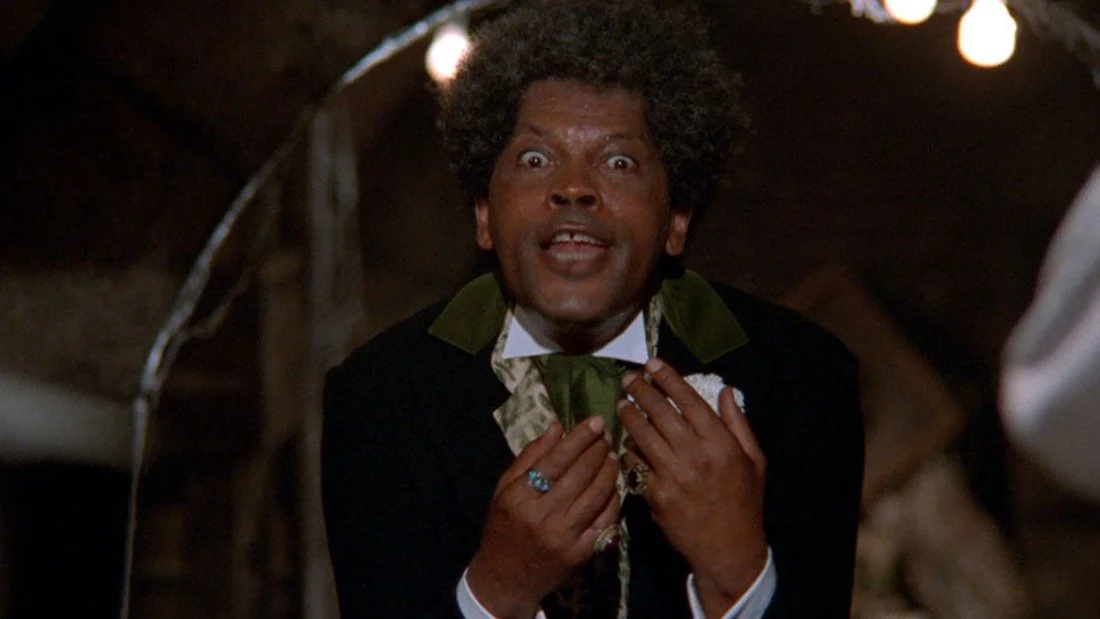TALES FROM THE HOOD (1995)
If any of y’all have read my bullshit before, you’re probably well aware that I’m all about good times and great oldies. My writing style is largely regurgitating quotes from The Simpsons, excitedly pointing out every Linnea Quigley cameo, type “GET TO THE CHOPPA” all in caps, and bing bang boom you’ve got yourself an article, right? But not everything can be a party. Sometimes life can take a dark turn with colors fading to gray. In times like these we’re forced to take things a little more [gulp] seriously. I know! You cool cats don’t need some dusty elder millennial “coming down” on you, but discussing topics such as systemic racism ought to be done with a bit more tact than my usual hackneyed hijinks so I figure we can start chronologically with Richard Wright’s novel Native Son then get right into Ralph Ellison’s Invisible Man and finish strong with Toni Morrison’s Beloved. What’s that? I only have 1,000 or so more words and it’s still the high holiday of Doll-O-Ween, you say? And you also are about good times and great oldies? But I thought I was the only one. So this is what it feels like.. when doves cry. Well, then I have just the thing! [thumbs through various books about werewolves until he arrives at a particular DVD, see “Glenn Danzig Interview On The Topic Of Books” true believers. Excelsior!]
1995’s TALES FROM THE HOOD is a horror anthology that elucidates the terror of the black American experience in the ‘90s through four scary short stories and a wicked wraparound tale. While the themes are indeed heavy they’re told through a hyperbolic horror lens tempered with humor and a hip hop aesthetic. While it stands to reason TALES FROM THE HOOD is influenced by British horror anthologies of the ‘70s like ASYLUM (1972) and TALES FROM THE CRYPT (1972), the creators also found inspiration from the implausible TALES FROM THE QUADEAD ZONE (1987) which was a no-budget shot-on-video blaxploitation horror anthology. The impetus for this chilling compendium originated from co-writer/director Rusty Cundieff’s one act play entitled "The Black Horror Show: Blackanthropy." After the play wrapped Cundieff found himself working with co-writer/producer Darin Scott on FEAR OF A BLACK HAT (1993) and Scott pitched Cundieff on a black centric casted horror portmanteau film. Cundieff agreed provided the story could speak to the trials and tribulations of black American culture at the time rather than just gone for cheap scares so the pair got to writing.
Now for my money a good anthology can be elevated to great by a solid wraparound story and that is exactly what we get with "Welcome to My Mortuary” as the prologue and epilogue for TALES FROM THE HOOD. It’s a compelling and logical set up with the funeral parlor set piece perfectly establishing the tone for the proceeding scary stories but the pièce de résistance is the wondrous Clarence Williams III as the scenery gobbling Mr. Simms! Mr. Simms acts as horror host to a trio of thugs with the character constructed drawing inspiration from KHJ-TV Channel 9 Los Angeles monster movie presenter "Seymour" played by Larry Vincent. It is through the maniacal Mr. Simms that each terrifying tale is told with the camp and comedy found in these interludes really ramping up the fun for this frightful foray and of course the frequency and fervor in which Mr. Simms says the word “shit” has become the stuff of legend.
The first proper story, titled "Rogue Cop Revelation,'' does not pull punches or tap dance around the social commentary. Rookie black police officer Clarence Smith witnesses three white veteran cops brutalizing city councilman Martin Ezekiel Moorehouse because he’s an activist crusading against police corruption. This story demonstrates the police’s capacity as the violent arm of systemic racism and shows that even presumably “good” cops can be compromised and complacent about the misdeeds of their colleagues. Sadly, an all too familiar story in 2023 but rather than staying ripped from the headlines the story makes a sharp supernatural swerve with the ghost of Moorehouse wreaking his bloody vengeance. Clarence is not exempt from reprisal, reaffirming that his moral obligation was to intervene in order to save Moorehouse and support the community. As Moorehouse says, “Where were you when I needed you, brother?” The makeup and creature effects on the ghoulish Moorehouse are gruesome and the mayhem exacted on the blighted boys in blue are as thematically clever as they are sadistically satisfying.
The second segment, entitled "Boys Do Get Bruised," is probably the most triggering due to the unfortunate truth that domestic abuse affects a wide swath of people regardless of race, age, or gender. Walter is the shy new kid in class being targeted by a schoolyard bully when attentive teacher Richard Garvey (played by director Rusty Cundieff) notices some of the young boy’s wounds are older. This in conjunction with Walter’s doleful demeanor and tendency to repetitively draw and talk of monsters in his house causes Mr. Garvey to suspect familiar violence. The plot thickens when Walter’s bully breaks every limb under mysterious circumstances. While the narrative handles the situation with realism and care, it can’t be overstated how bold of a choice it was casting lauded comedic actor David Alan Grier in the role of brutal abusive boyfriend, Carl. Casting against type for Carl makes the viewer doubt the validity of Walter’s fears which only adds to the impact when Grier finally delivers with a pitch perfect performance as a genuinely scary bastard. Mr. Simms hints at this at the very beginning of the story with the line “It’s a classic case of what is and isn’t real in the mind of a boy named Walter.” Of course Carl looks like a normal, unassuming guy but as we all know regular people are capable of monstrous acts. Watching Carl’s flattened frame burst into flames makes for a vindicating bit of voodoo ending the vignette in a vicious way.
In our third tale we get the reason for the season of Doll-O-Ween with "KKK Comeuppance.” Anecdotally, there’s a ton of people about my age who find this to be the most terrifying vignette in the anthology. I remember kids in school talking of similar stories from grandparents about dolls imbued with lost souls. The ‘90s, man. This segment pits Corbin Bernsen’s Duke Metger against a gaggle of possessed dolls. Metger is former Klu Klux Klansman now senatorial hopeful operating out of a plantation house much to the chagrin of at least a portion of his potential constituency. On top of that, the plantation was the scene of a mass slaughtering of former slaves during the last days of the Civil War. Local hoodoo witch Miss Cobbs (modeled after Cundieff’s real life mother) transfers the spirits of the killed slaves into her fashioned dolls. As Mr. Simms explains in his introduction to the story “Sometimes when a person’s body has been through a lot the soul is displaced. This doll is a place for the soul to survive until it can move on.” Pretty boilerplate soul stuff as any fan of THE CROW (1994) can attest to.
The racist antics of Duke Metger make for some appropriate business to finish and a dynamite doll centric donnybrook. Aside from the perilous pitter patter of little feet we get several fun stop motion scenes of the foot tall fiends swinging from chandeliers and dodging shotgun blasts. It may sound silly but this story about reanimated dolls addresses the racial implications of inherited wealth in America. Duke’s ancestry amassed affluence through subjugation and after denouncing affirmative action and reparations we literally see him attempt to defend himself from the dolls using the American flag as both a weapon and a shield. If that doesn’t speak volumes about how generational wealth is protected in this country then the climax of the story definitely does with Duke being devoured by the dolls in the most literal interpretation of the slogan “eat the rich.”
Probably the most misunderstood vignette comes in fourth with "Hard-Core Convert.” Scott and Cundieff add a gangster pastiche and an urban patois in a hood reimagining of A CLOCKWORK ORANGE (1971). After gunning down an acquaintance in an altercation, Crazy K is felled in hail of gunfire himself only to be saved by the cops and become a candidate for some kind of radical rehabilitation. The chilling conversation between Crazy K and a white supremacists and use of real life photo and film of lynchings brings a terrifying realism to this indictment of black on black violence. Ultimately Crazy K is presented with the possibility of redemption, even if it is just in his own mind, but he rejects it in yet another example of American masculinity gone wrong which serves as a throughline for the film. Bulldog pressures Ball and Stack to go into the mortuary by questioning their manhood. Mr. Simms gets the thugs to listen to his stories by questioning whether or not they’re too scared. Officer Strom bullies Billy and Newton into going along with their murder and later desecration of Moorehouse and Newton bullies Smith into keeping quiet; all suggesting anyone who doesn’t go along is a “pussy.” Duke’s money and power makes him feel invincible despite the warnings to atone and leave the plantation. Crazy K follows suit with his last utterances being a defiant “I don’t give a fuck.”
This ties in perfectly to the "Welcome to My Mortuary” epilogue. With Bulldog, Ball, and Stack revealed to be Crazy K’s killers, Clarence Williams III really turns his Mr. Simms character up to 11, even dropping a reference to acclaimed rap group Public Enemy. “This ain't no funeral home! It ain't the Terrordome, neither! Welcome to Hell, motherfuckers!” And with that the frightful fable comes to a fiery end. It’s a compendium of creepy camp with a social conscience and as you might have guessed from my incessant rambling, I love talking about this fantastic film. Co-writer Darin Scott reminisced on the project saying “The only sad thing is that the stories from TALES FROM THE HOOD work just as well now as they did then because we still have the same problems.” A sobering thought but art like this needs to be made not just so we can see how far we’ve come, but rather how much further we still need to go.






